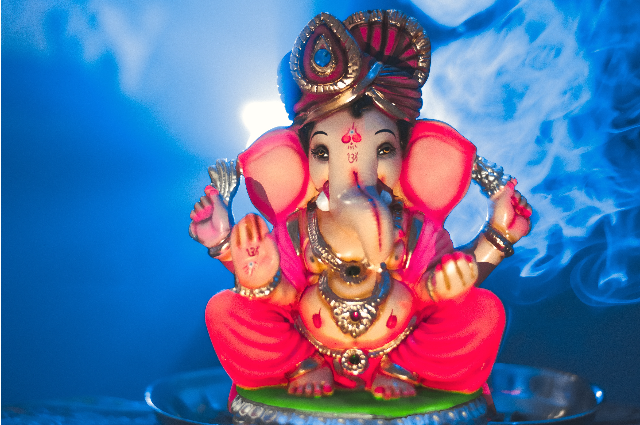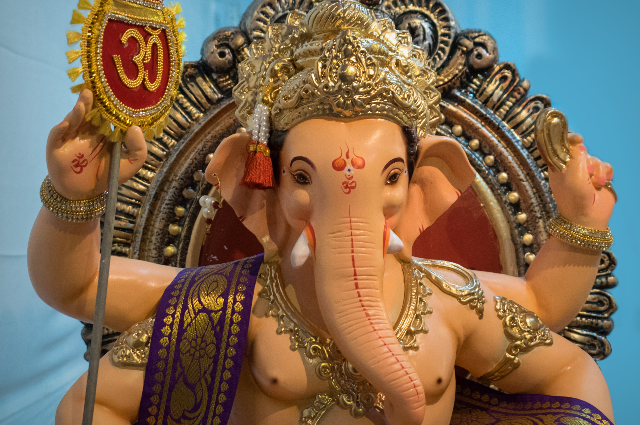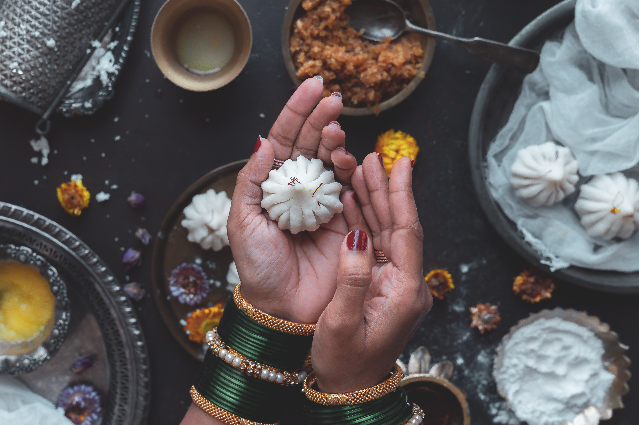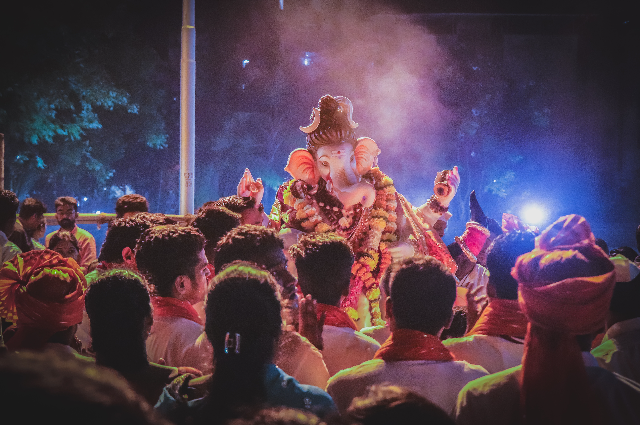
“Vakratunda Maha-Kaaya Surya-Kotti Smaprabha
Nirvighnam Kuru Me Deva Sarva-Kaaryeshu Sarvadaa II
Introduction:
Ganesh Chaturthi is observed to celebrate the arrival of Ganesha with His mother goddess Gouri on earth from Kailash. The festival continues for eleven days starting on Ganesha Chaturthi and ends on the fourteenth day of the fortnight i.e. Anant Chaturdashi. As per the Gregorian calendar the days generally fall on late August or early September. Ganesha Chaturthi is also known as Vinayaka Chaturthi.
Etymology:
Ganesha or Ganapati is the most worshipped god in Hinduism because Lord Shiva bestowed Him with the blessings that no puja would be accomplished before worshipping Lord Ganesha. Lord Ganesha epitomises Buddhi (intellect), Riddhi (prosperity) and Siddhi (spiritual power). Besides, He is considered the annihilator of all obstacles of life. Ganesha is etymologically the compound of two Sanskrit words ‘gana’ denoting a group or mass and ‘isha’ meaning God or lord. The mention of Ganapati in Rig-Veda and Yajur Veda substantiates the antiquity of this pot bellied, elephant faced god dating back to thousands of years.
Legends of Elephant Head:
There are myriad mythological stories and anecdotes of Lord Ganesha obtaining His elephant head. According Shiva Purana in absence of Nandi, a trusted accomplice of Lord Shiva, Parvati shaped a boy out of the turmeric paste from Her body and infused life into it to guard the door until She finished Her ablution.
But when Lord Shiva, a stranger to the boy, expressed His wish to meet Parvati, an unwanted trouble arose. Much to Shiva’s dismay, the boy was determined to stick to His mother’s command and impeded Him to meet Parvati. A fierce battle ensued between Lord Shiva and the boy. At last, Lord Shiva with His Trisul (trident) decapitated the boy.
Being livid beyond limit, goddess Parvati threatened to annihilate all creations. Then Lord Brahma manifested to placate the inconsolable mother Parvati on conditions of the boy to be revived and worshipped before the puja of all the other gods. Lord Shiva also repented for His misdeed. As per the direction of Lord Shiva, His aides fetched the head of a strong and powerful elephant Gajasura. Lord Brahma set the elephant head onto the boy’s body and Lord Ganesha was thus created.
On the other hand, the wish of Gajasura was also fulfilled. Once Lord Shiva was satisfied by the austerity exhibited during penance by Gajasura, a demon with the characteristics of an elephant. The demon expressed his desire that Lord Shiva should inhabit in his stomach. Lord Shiva granted his wish. Finding no trace of Lord Shiva, His consort Parvati entreated Lord Vishnu to find out Her husband.
Then Lord Vishnu arranged a cosmic dance performed by Nandi (the bull of Shiva) in cadence with the melodious notes of the flute played by Him. Gajasura was so enraptured with the performance of the duo that he wished to fulfil any desire of the flutist who was none other than Lord Vishnu. As per Vishnu’s desire, Gajasura liberated Lord Shiva from his stomach. Then Lord Shiva blessed Gajasura that his head would be adorned by everybody.
Brahma Vaivarta Purana tells another legend behind the elephant head of Lord Ganesha. After Parvati gave birth to a refulgent baby, all the gods and goddesses including Shani (Saturn) were invited to bless the new born baby. But no sooner had Shani, who is notorious for his cataclysmic gaze, beheld the baby than his head was decapitated from his torso. Then Lord Vishnu mounting on His divine vehicle Garuda fetched the head of a young elephant from the Pushpa Bhadra River and fixed it on the child’s torso.
Lord Shiva, in another mythological story, by mistake decapitated Aditya, the son of Kashyapa, one of the great seven Rishis (sages). Later, Shiva repented his misdeed and substituted Aditya’s head with the head of Devraj Indra’s elephant Airavata. The enraged Rishi cursed Lord Shiva to face the same awkward predicament.
According to Padma Purana, Goddess Ganga is considered the foster mother of Lord Ganesha. Goddess Parvati out of the fragrant oily paste applied to her body moulded the figure of a boy with elephant head. The creation of a strange figure out of Her caprice was later immersed in the river Ganga. The figure springing to life in contact with sacred water of the river was recognized as Lord Ganesha.
In another legend, the sacred water spilling from the body of Goddess Parvati while bathing mingled with the river Ganga. The elephant-headed goddess Malini drank the sacred water and gave birth to a child with five elephant heads. Lord Shiva gave recognition of the child as the son of Goddess Parvati. Lord Shiva reduced the five elephant heads into one.

Broken Tusk:
There are several stories on the broken tusk of Lord Ganesha. According to Brahmanda Purana, Parashuram, the sixth avatar of Lord Vishnu, was overwhelmed with gratitude to Lord Shiva Who empowered him to win the fight with Kartavirya Arjuna. He came to pay His obeisance to Lord Shiva at Mount Kailash. But Ganesha prevented Him from meeting His father who was then sleeping. Then Parashuram hurled his axe. But Ganesha restrained Himself as the axe was bestowed to Parashurama by His father Lord Shiva. He embraced the blow in His left tusk. The chopped tusk fell on the ground.
According to another popular legend, Ganesha lost his tusk while writing the manuscript of the Mahabharata. Advised by Lord Brahma, Maharshi Veda Vyas entreated Ganesha to write the manuscript of the great scripture. While writing the manuscript of the epic, the feather of His pen broke. Then Ganesha pulled out His left tusk to complete the assignment He was entrusted with.
There is also a funny story about Ganesha losing his task. One full moon night while Ganesha was returning after relishing a sumptuous dinner from Kubera’s palace, He stumbled down on the ground. All the food He had eaten popped out of His belly. Noticing this, the god Moon could not restrain Himself and burst out laughing. Ganesha being offended hurled His tusk and broke the god Moon into two and also cursed Him to be invisible. He cursed the moon that if one sees the god Moon on the day of Ganesha Chaturthi, one will fail to attain ‘moksha’ (emancipation from the cycle of death and birth). Therefore, viewing the Moon on Ganesha Chaturthi is considered inauspicious.
Eight Incarnations:
In Mudgala Purana, Lord Ganesha like other major gods assumed eight avatars or incarnations to subdue eight innate enemies of human beings. Lord Ganesha in His first incarnation of Vakratunda destroyed Matsarasura, the demonic form of jealousy. He assumed Ekadanta incarnation to kill Madasura, symbolizing arrogance. He subdued Mohasur, the demon of delusion and confusion, in His Mohodara incarnation. Greed in the form of Lobhasura was killed by Lord Ganesha in His incarnation known as Gajanana. Then Lord Ganesha in His Lambodara incarnation destroyed Krodhasura, the embodiment of anger. Lust and desire in the form of Kamasura was defeated by Vikata avatar of Lord Ganesha. He forming the incarnation of Vighnaraja annihilated Mamasura, the demon of attachment. In His eighth incarnation of Dhumravarna, Lord Ganesha exterminated Ahamkarsura, the demon of ego.
Ganesha’s Vahana:
According to Ganesha Purana, a celestial musician god named Krauncha, a divine mouse, prayed to Ganesha to reduce His weight so that he could support Him. Lord Ganesha granted his prayer allowing the divine mouse to be His vehicle. Therefore, mouse or rodent is popularly considered the ‘vahana’ (divine vehicle) of Lord Ganesha. Besides, Lord Ganesha used different ‘vahanas’ like lion, divine peacock and Sheshnag during His incarnations of Vakratunda, Vikata and Vighnaraja respectively.
Love and Marital Life:
There are many interesting stories regarding Lord Ganesha’s love and marital life. Goddess Tulsi, enamoured by Ganesha’s resplendent attire of yellow garment and sandal paste smearing all over His body in His ascetic form, sought Him as her consort. But Ganesha politely turned down her marriage proposal. This humiliated Tulsi to the point of disappointment. She cursed Ganesha that He would be destined to accept a forceful marriage against His will. Ganesha also cursed her to be condemned to marry a demon. Therefore, Tulsi leaves are not offered to Ganesha because of their entanglement in mutual curses. In this story Ganesha is identified as a ‘Brahmachari’ (celibate) with no consort.
In another mythological story, Siddhi (power of spirituality) and Riddhi (power of prosperity), the daughters of Prajapati Vishwaroopa, are the two consorts of Lord Ganesha. They are blessed with two beautiful sons Khema (protection) and Labh (profit). The wives and sons of Lord Ganesha are the divine incarnations of the qualities that are attained by worshipping the elephant-faced god.

Prasadam:
Modak is popularly served as prasadam of Lord Ganesha. The main ingredients of modak are flour, grated coconut and jaggery. There are a variety of modaks namely Mava Modak, Kesari Modak, Moong Dal Modak etc. On the other hand, Chocolate Modak and Paneer Modak are the modern versions of the dessert. Twenty one Modaks are offered to Lord Ganesha as prasadam.
Symbolisms: The idol of Lord Ganesha entails a lot of symbolism. Different people interpret differently. Trunk like that of the elephant symbolizes strength and strong sense of discrimination to differ good from evil. Two big ears suggest the power of listening and concentration that one needs to acquire knowledge. The pot belly is the symbol of a huge container that can absorb everything gracefully. His single tusk signifies the weariness of the mundane world and true knowledge beyond dichotomy. The sitting posture of Lord Ganesha with one leg resting on the ground and the other folded up symbolizes the dilemma between material and divine world.
Besides, the hands of Lord Ganesha are adorned with some common things. In one hand He holds a lotus, the symbol of enlightenment. The laddu in one of his hands stands for the sweet result of spiritual elevation attained after penance. The noose or hatchet symbolizes delusion of the material world. One will escape the noose only when one attains true salvation i.e. Moksha. Another hand with blessing posture suggests assurance bestowed to the devotees by Lord Ganesha.

Ganesha Festivals:
Ganesh Chaturthi or Vinayaka Chaturthi is one of the major festivals observed with pomp and gaiety mainly in Maharashtra, Karnataka, Gujarat, Tamil Nadu and Madhya Pradesh and in our neighbouring country Nepal. Besides, the festival is observed with much enthusiasm by Hindu diaspora in Australia, South Africa, Trinidad and Tobago, Mauritius, America and many European countries.
In Other Religions & Nations: Lord Gonesha like other popular Hindu deities is worshipped in different names in countries transcending the boundary of India. In Burma Ganesha is popular as Maha Peinne, whereas in Thailand the elephant headed god is worshipped in the name of Phra Phikanet. In Sri Lanka He is worshipped as Gana deviyo.
The Buddhists and Janists worship Lord Ganesha with great devotion. In Japanese Buddhism, Kangiten representing a pair of elephants of opposite sexes in mating posture is considered Lord Ganesha. In Indonesia Ganesha is worshipped as the ‘Indonesian God of Wisdom’. Ganesha dancing posture is worshipped as the Destroyer of Obstacles, whereas, Ganapati, Maha Rakta is the Tantric Buddhist form of Ganesha. But, in China, Lord Ganesha is very often represented as the obstacle instead of the remover of it.
